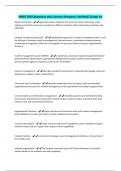NIMS 100-Questions and Correct Answers/ Verified/ Grade A+
Whole community - ✔️✔️approach ensures solutions that serve the entire community, while
making sure that the resources coming from different members of the community are being used
efficiently
Incident command system (ICS) - ✔️✔️standardized approach to incident management that is used
for all kinds of incidents (small to emergencies), planned events, coordination response among
jurisdictions and agencies, allows for interrogation of resources within a common organizational
structure
Incident management system (NIMS) - ✔️✔️a systematic, proactive response to guide all levels of
government (non government organizations (NGOS) and the private sector) to work together to
prevent, protect against, respond to, and recover all incidents
resource management - ✔️✔️describes standard mechanisms to systematically manage resources
(equipment, supplies, teams, and facilities)
Command and Coordination - ✔️✔️describes leadership roles, processes, and recommended
organizational structures for incident management at the operational and incident support levels
communication and information management - ✔️✔️describes systems and methods that help
ensure that incident personnel and other decision makers have the means and information they
need to make and communicate decisions
organizational functions - ✔️✔️major functions and functional units with incident management
responsibilities are names and defines remain standard and consistent
resource descriptions - ✔️✔️major resources (personnel, equipment, teams, facilities) are given
common names and are "typed" with respect to their capabilities
Incident Facilities - ✔️✔️common terminology is used to designate the facilities in the vicinity of
the incident area
modular organization - ✔️✔️The incident command system (ICS) that developes in a modular
fashion based on the incidents size and complexity
, incident commander/ unified command - ✔️✔️establishes innocent objectives that drive incident
operations
management by objectives - ✔️✔️includes establishing specific, measurable incident objectives,
identifying strategies, tactics, tasks to achieve the objectives, developing assignments, plans,
procedures and protocols to accomplish identified tasks, documenting results
incident action planning - ✔️✔️capturing and communicating overall incident priorities, objectives,
strategies, tactics and assignments in the contexts of the operation
the IAP - ✔️✔️cover time-frame, specify the incident objectives, state the activities to be
completed, assign responsibilities, identify needed resources, communicate protocols
span of control (one supervisor to five subordinates 1:5) - ✔️✔️number of individuals or resources
that one supervisor can manage during incident
comprehensive resource management - ✔️✔️standard mechanisms to identify requirements, order
and acquire, track and report, restock resources (personnel, teams, facilities, equipment, and
supplies)
Integrated communications - ✔️✔️necessary to maintain connectivity, achieve situational
awareness, facilitate information sharing
establishment and transfer command - ✔️✔️clearly established at the beginning of an incident,
jurisdiction or organization have primary responsibility for the incident designates. process includes
briefing that captures all essential information for continuing safe and effective operations
unified command - ✔️✔️allows agencies with different legal, geographic, and functional
responsibilities to work together effectively without affecting individual agencies or accountability. Is
used when no single agency has the resources to manage incident on its own
chain of command - ✔️✔️orderly line that details how authority flows through the hierarchy of the
incident management organization. allows incident commander to direct and control action, avoids
confusion by requiring orders to flow from supervisors




